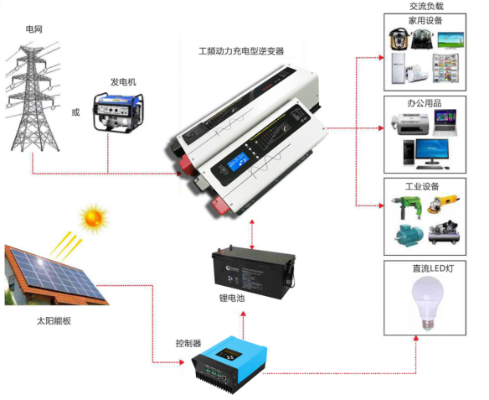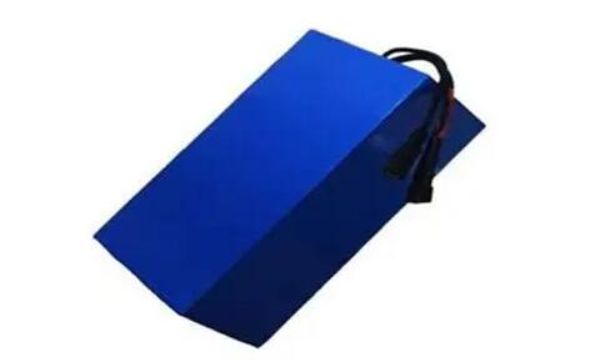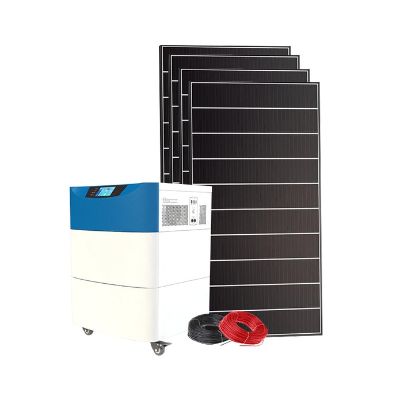LATEST NEWS
- 01How is photovoltaic power generation integrated into the grid?
- 02How to maintain and maintain the solar panels of photovoltaic power plants?
- 03Do a good job in daily maintenance and build a high-quality photovoltaic power station
- 04About the time calculation method of the battery capacity of the UPS power supply/inverter
- 05Safe use of inverter power
- 06Instructions for use of multi-function inverter

No. 3, Hongli Road, Miaobian Village, Liaobu Town, Dongguan City, Guangdong Province, China
Address:Jinweiyuan Science and Technology Park,No.41,Qingsong Road, LongtianStreet,Pingshan District, Shenzhen City, Guangdong Province
TEL: (+086)15220276096 (+086)13713796273
e-Mail: nuoshengbang@yeah.net
e-Mail:szhuanyu2004@sina.com
company news
Homecompany newsDetails
Do a good job in daily maintenance and build a high-quality photovoltaic power station
Publish: 2022-01-16 20:33:17 View: 1847
Photovoltaic power generation is not only green and environmentally friendly, but also in line with the concept of low-carbon life. It can also make better use of the earth's renewable energy to protect the earth. However, in the normal use process, maintenance is also required, which can not only ensure the stable power generation of the power station, but also ensure the service life or even prolong the service life. How to maintain and manage photovoltaic power plants? , The maintenance of photovoltaic power plants can guarantee 25 years of operation. Today, we will talk about how to maintain photovoltaic power plants from 8 aspects, which are suitable for distributed and centralized photovoltaic power plants.
(1) The surface of photovoltaic modules should be kept clean, and the photovoltaic modules should be wiped with a dry or damp, soft and clean cloth. It is strictly forbidden to use corrosive solvents or hard objects to wipe the photovoltaic modules. PV modules should be cleaned when the irradiance is lower than 200W/㎡, and it is not advisable to use liquids with a large temperature difference from the modules to clean the modules.
(2) Photovoltaic modules should be checked regularly. If the following problems are found, the photovoltaic modules should be adjusted or replaced immediately.
Photovoltaic modules have broken glass, scorched backplanes, and obvious color changes;
There are air bubbles in the PV module that form a communication channel with the edge of the module or any electrical circuit;
The photovoltaic module junction box is deformed, twisted, cracked or burned, and the terminals cannot be in good contact.
(3) The live warning signs on the photovoltaic modules must not be lost.
(4) For photovoltaic modules using metal frame, the frame and bracket should be well combined, the contact resistance between the two should not be greater than 4Ω, and the frame must be firmly grounded.
(5) When working without shadows, under the condition that the solar irradiance is above 500W/㎡ and the wind speed is not greater than 2m/s, the temperature difference of the outer surface of the same photovoltaic module (the area directly above the battery) should be less than 20℃ . Photovoltaic power plants with an installed capacity greater than 50kWp should be equipped with infrared thermal imaging cameras to detect temperature differences on the outer surface of photovoltaic modules.
(6) Use a DC clamp-type ammeter to measure the input current of each PV module string connected to the same DC combiner box under the condition that the solar radiation intensity is basically the same, and the deviation should not exceed 5%.
(7) All bolts, welds and bracket connections of the bracket should be firm and reliable, and the anti-corrosion coating on the surface should not crack and fall off, otherwise it should be brushed in time.
Maintenance of the combiner box
(1) The DC combiner box shall not be deformed, corroded, leaked, or deposited ash. The safety warning signs on the outer surface of the box shall be intact and undamaged, and the waterproof lock on the box shall be flexible to open and close.
(2) The terminals in the DC combiner box should not be loose or corroded.
(3) The specifications of the high-voltage DC fuses in the DC combiner box should meet the design regulations.
(4) The insulation resistance of the positive pole to the ground and the negative pole to the ground of the DC output bus should be greater than 2 megohms.
(5) The DC circuit breaker equipped at the DC output bus end shall have flexible and reliable breaking functions.
(6) The lightning arrester in the DC combiner box should be effective.
Maintenance of DC distribution cabinet
(1) The DC power distribution cabinet shall not be deformed, corroded, leaked, or deposited. The safety warning signs on the outer surface of the box shall be intact and undamaged, and the waterproof lock on the box shall be opened flexibly.
(2) The terminals in the DC power distribution cabinet should not be loose or corroded.
(3) The insulation resistance of the positive pole to the ground and the negative pole to the ground of the DC output bus should be greater than 2 megohms.
(4) The connection between the DC input interface of the DC power distribution cabinet and the combiner box should be stable and reliable.
(5) The connection between the DC output of the DC power distribution cabinet and the DC input of the grid-connected host should be stable and reliable.
(6) The action of the DC circuit breaker of the DC power distribution cabinet should be flexible, and the performance should be stable and reliable.
(7) The lightning arrester configured on the output side of the DC bus should be effective.
Inverter maintenance
(1) The inverter structure and electrical connection should be kept intact, and there should be no corrosion, dust accumulation, etc., the heat dissipation environment should be good, and there should be no large vibration and abnormal noise when the inverter is running.
(2) The warning signs on the inverter should be intact and not damaged.
(3) The cooling fans of the modules, reactors, and transformers in the inverter should function normally to start and stop automatically according to the temperature. There should be no large vibration and abnormal noise when the cooling fans are running.
(4) Disconnect the circuit breaker on the AC output side (grid side) once regularly, and the inverter should immediately stop feeding power to the grid.
(5) If the temperature of the DC bus capacitor in the inverter is too high or exceeds the service life, it should be replaced in time.
Maintenance of AC power distribution cabinet
(1) Ensure that the metal frame of the power distribution cabinet and the basic steel are well connected with galvanized bolts, and the anti-loosening parts are complete.
(2) The identification devices of the power distribution cabinet indicating the number, name or operation position of the controlled equipment should be complete, and the number should be clear and neat.
(3) The busbar joints should be tightly connected, without deformation, without blackening marks of discharge, without loosening and damage of insulation, and without rusting of tightening bolts.
(4) The push-pull of the handcart and the withdrawable complete power distribution cabinet should be flexible, and there should be no jamming and collision phenomenon. The center lines of the static and dynamic contacts should be consistent, and the contacts should be in close contact.
(5) The switches and main contacts in the power distribution cabinet have no burning marks, and the arc extinguishing cover has no burning black and damage. Tighten the wiring screws and clean the dust in the cabinet.
(6) Take out each sub-switch cabinet from the drawer, and fasten each terminal. Check the installation and wiring of current transformers, ammeters, and watt-hour meters. The handle operating mechanism should be flexible and reliable. Tighten the incoming and outgoing wires of the circuit breaker, and clean the dust in the switch cabinet and the lead wires behind the power distribution cabinet.
(7) The heat dissipation of low-voltage electrical appliances should be good, the switching pressure plate should be released well, and the signal lights, buttons, light signs, electric bells, torches, accident electric bells and other actions and signals of the signal circuit should be displayed accurately.
(8) Inspect the insulation resistance value between the lines and between the lines and the ground of the lines between the cabinets, screens, tables, boxes and panels. The feeder line must be greater than 0.5MΩ, and the secondary circuit must be greater than 1MΩ.
Transformer Maintenance
(1) The thermometer of the transformer should be in good condition, the oil temperature should be normal, the oil level of the oil conservator should correspond to the ambient temperature, and there should be no seepage or oil leakage in all parts. The load size, cooling conditions and seasons of each transformer may be different. The transformer in operation should not be based solely on the oil temperature of the upper layer not exceeding the allowable value. It should also be based on previous operating experience and comparison with the previous oil temperature under the above conditions.
(2) The oil level of the casing should be normal, and there should be no damage, cracks, serious oil stains, discharge traces and other abnormal phenomena on the outside of the casing. The oil level should conform to the standard line of ambient temperature. If the oil level is too low, check the transformer for oil leakage. If the oil level is too high, check the use of the cooling device to see if there is any internal failure.
(3) The sound response of the transformer is normal, and there is generally a uniform humming electromagnetic sound during normal operation. If the sound is abnormal, you should check it carefully, make a correct judgment, and deal with it immediately.
(4) There should be no broken strands in the lead wires of the transformer, no overheating discoloration or melting (discoloration) of the temperature indicator in the joints, the respirator should be in good condition, and the degree of discoloration of the silicone gel should not exceed 3/4.
(5) The tap position and power indication of the excitation voltage regulating tap-changer should be normal, there should be no gas in the gas relay, and the grounding of the transformer shell and the iron core should be in good condition.
(6) In bad weather, special inspections should be carried out. When the wind is strong, check whether the lead wire swings violently and whether the sag is sufficient. There should be no debris at the top cover of the transformer and the lead wire of the bushing. In heavy snow, the contacts of each part should not melt or discharge immediately after the snow falls. In foggy days, whether there is spark discharge in each department, etc.
Maintenance of cables
(1) The cable should not run under overload, and the lead package of the cable should not expand or crack.
(2) The parts of the cables entering and leaving the equipment should be sealed well, and there should be no holes with a diameter greater than 10mm, otherwise they should be blocked with fireproof mud walls.
(3) In the place where the cable has too much pressure and tension on the equipment shell, the supporting point of the cable should be intact.
(4) There should be no perforations, cracks and significant unevenness at the mouth of the cable protection steel pipe, the inner wall should be smooth, the metal cable pipe should not be severely corroded, and there should be no burrs, hard objects, and garbage. If there are burrs, use them after filing. The cable jacket is wrapped and tied tightly.
(5) The accumulations and garbage in the outdoor cable well should be cleaned up in time. If the cable sheath is damaged, it should be dealt with.
(6) When checking the open trench of indoor cables, it is necessary to prevent damage to the cable and ensure that the bracket is grounded and the heat dissipation in the trench is good.
(7) The stakes along the direct buried cable line should be intact, and the ground near the route should not be excavated to ensure that no heavy objects, building materials and temporary facilities are stacked on the ground along the route, and no corrosive substances are discharged to ensure that the outdoor exposed ground cable protection facilities are intact .
(8) Ensure that the cover plate of the cable trench or cable well is intact, there should be no water or debris in the trench, ensure that the bracket in the trench should be firm, and there should be no corrosion or looseness, and the sheath of the armored cable and armor should not have any Severely corroded.
(9) For multiple cables laid in parallel, the current distribution and the temperature of the cable sheath should be checked to prevent the cables from burning out the connection points due to poor contact.
(10) Ensure that the cable terminals are well grounded, the insulating sleeves are intact, clean, and have no traces of flashover discharge, and ensure that the color of the cables should be obvious.
Extreme Weather Maintenance
(1) If it is raining and tripping, it may be that the wiring head is not tight. If such a situation occurs, it must be dealt with after the rain and sunny days. The wiring head can be wrapped with insulating tape, and then observe whether the tripping occurs. If the tripping phenomenon continues, It should be reported to the service center or local power station.
(2) In thunderstorm days, the air switch below the meter should be turned off to prevent damage to electrical equipment. After the thunderstorm is over, turn the switch back on.
(1) The surface of photovoltaic modules should be kept clean, and the photovoltaic modules should be wiped with a dry or damp, soft and clean cloth. It is strictly forbidden to use corrosive solvents or hard objects to wipe the photovoltaic modules. PV modules should be cleaned when the irradiance is lower than 200W/㎡, and it is not advisable to use liquids with a large temperature difference from the modules to clean the modules.
(2) Photovoltaic modules should be checked regularly. If the following problems are found, the photovoltaic modules should be adjusted or replaced immediately.
Photovoltaic modules have broken glass, scorched backplanes, and obvious color changes;
There are air bubbles in the PV module that form a communication channel with the edge of the module or any electrical circuit;
The photovoltaic module junction box is deformed, twisted, cracked or burned, and the terminals cannot be in good contact.
(3) The live warning signs on the photovoltaic modules must not be lost.
(4) For photovoltaic modules using metal frame, the frame and bracket should be well combined, the contact resistance between the two should not be greater than 4Ω, and the frame must be firmly grounded.
(5) When working without shadows, under the condition that the solar irradiance is above 500W/㎡ and the wind speed is not greater than 2m/s, the temperature difference of the outer surface of the same photovoltaic module (the area directly above the battery) should be less than 20℃ . Photovoltaic power plants with an installed capacity greater than 50kWp should be equipped with infrared thermal imaging cameras to detect temperature differences on the outer surface of photovoltaic modules.
(6) Use a DC clamp-type ammeter to measure the input current of each PV module string connected to the same DC combiner box under the condition that the solar radiation intensity is basically the same, and the deviation should not exceed 5%.
(7) All bolts, welds and bracket connections of the bracket should be firm and reliable, and the anti-corrosion coating on the surface should not crack and fall off, otherwise it should be brushed in time.
Maintenance of the combiner box
(1) The DC combiner box shall not be deformed, corroded, leaked, or deposited ash. The safety warning signs on the outer surface of the box shall be intact and undamaged, and the waterproof lock on the box shall be flexible to open and close.
(2) The terminals in the DC combiner box should not be loose or corroded.
(3) The specifications of the high-voltage DC fuses in the DC combiner box should meet the design regulations.
(4) The insulation resistance of the positive pole to the ground and the negative pole to the ground of the DC output bus should be greater than 2 megohms.
(5) The DC circuit breaker equipped at the DC output bus end shall have flexible and reliable breaking functions.
(6) The lightning arrester in the DC combiner box should be effective.
Maintenance of DC distribution cabinet
(1) The DC power distribution cabinet shall not be deformed, corroded, leaked, or deposited. The safety warning signs on the outer surface of the box shall be intact and undamaged, and the waterproof lock on the box shall be opened flexibly.
(2) The terminals in the DC power distribution cabinet should not be loose or corroded.
(3) The insulation resistance of the positive pole to the ground and the negative pole to the ground of the DC output bus should be greater than 2 megohms.
(4) The connection between the DC input interface of the DC power distribution cabinet and the combiner box should be stable and reliable.
(5) The connection between the DC output of the DC power distribution cabinet and the DC input of the grid-connected host should be stable and reliable.
(6) The action of the DC circuit breaker of the DC power distribution cabinet should be flexible, and the performance should be stable and reliable.
(7) The lightning arrester configured on the output side of the DC bus should be effective.
Inverter maintenance
(1) The inverter structure and electrical connection should be kept intact, and there should be no corrosion, dust accumulation, etc., the heat dissipation environment should be good, and there should be no large vibration and abnormal noise when the inverter is running.
(2) The warning signs on the inverter should be intact and not damaged.
(3) The cooling fans of the modules, reactors, and transformers in the inverter should function normally to start and stop automatically according to the temperature. There should be no large vibration and abnormal noise when the cooling fans are running.
(4) Disconnect the circuit breaker on the AC output side (grid side) once regularly, and the inverter should immediately stop feeding power to the grid.
(5) If the temperature of the DC bus capacitor in the inverter is too high or exceeds the service life, it should be replaced in time.
Maintenance of AC power distribution cabinet
(1) Ensure that the metal frame of the power distribution cabinet and the basic steel are well connected with galvanized bolts, and the anti-loosening parts are complete.
(2) The identification devices of the power distribution cabinet indicating the number, name or operation position of the controlled equipment should be complete, and the number should be clear and neat.
(3) The busbar joints should be tightly connected, without deformation, without blackening marks of discharge, without loosening and damage of insulation, and without rusting of tightening bolts.
(4) The push-pull of the handcart and the withdrawable complete power distribution cabinet should be flexible, and there should be no jamming and collision phenomenon. The center lines of the static and dynamic contacts should be consistent, and the contacts should be in close contact.
(5) The switches and main contacts in the power distribution cabinet have no burning marks, and the arc extinguishing cover has no burning black and damage. Tighten the wiring screws and clean the dust in the cabinet.
(6) Take out each sub-switch cabinet from the drawer, and fasten each terminal. Check the installation and wiring of current transformers, ammeters, and watt-hour meters. The handle operating mechanism should be flexible and reliable. Tighten the incoming and outgoing wires of the circuit breaker, and clean the dust in the switch cabinet and the lead wires behind the power distribution cabinet.
(7) The heat dissipation of low-voltage electrical appliances should be good, the switching pressure plate should be released well, and the signal lights, buttons, light signs, electric bells, torches, accident electric bells and other actions and signals of the signal circuit should be displayed accurately.
(8) Inspect the insulation resistance value between the lines and between the lines and the ground of the lines between the cabinets, screens, tables, boxes and panels. The feeder line must be greater than 0.5MΩ, and the secondary circuit must be greater than 1MΩ.
Transformer Maintenance
(1) The thermometer of the transformer should be in good condition, the oil temperature should be normal, the oil level of the oil conservator should correspond to the ambient temperature, and there should be no seepage or oil leakage in all parts. The load size, cooling conditions and seasons of each transformer may be different. The transformer in operation should not be based solely on the oil temperature of the upper layer not exceeding the allowable value. It should also be based on previous operating experience and comparison with the previous oil temperature under the above conditions.
(2) The oil level of the casing should be normal, and there should be no damage, cracks, serious oil stains, discharge traces and other abnormal phenomena on the outside of the casing. The oil level should conform to the standard line of ambient temperature. If the oil level is too low, check the transformer for oil leakage. If the oil level is too high, check the use of the cooling device to see if there is any internal failure.
(3) The sound response of the transformer is normal, and there is generally a uniform humming electromagnetic sound during normal operation. If the sound is abnormal, you should check it carefully, make a correct judgment, and deal with it immediately.
(4) There should be no broken strands in the lead wires of the transformer, no overheating discoloration or melting (discoloration) of the temperature indicator in the joints, the respirator should be in good condition, and the degree of discoloration of the silicone gel should not exceed 3/4.
(5) The tap position and power indication of the excitation voltage regulating tap-changer should be normal, there should be no gas in the gas relay, and the grounding of the transformer shell and the iron core should be in good condition.
(6) In bad weather, special inspections should be carried out. When the wind is strong, check whether the lead wire swings violently and whether the sag is sufficient. There should be no debris at the top cover of the transformer and the lead wire of the bushing. In heavy snow, the contacts of each part should not melt or discharge immediately after the snow falls. In foggy days, whether there is spark discharge in each department, etc.
Maintenance of cables
(1) The cable should not run under overload, and the lead package of the cable should not expand or crack.
(2) The parts of the cables entering and leaving the equipment should be sealed well, and there should be no holes with a diameter greater than 10mm, otherwise they should be blocked with fireproof mud walls.
(3) In the place where the cable has too much pressure and tension on the equipment shell, the supporting point of the cable should be intact.
(4) There should be no perforations, cracks and significant unevenness at the mouth of the cable protection steel pipe, the inner wall should be smooth, the metal cable pipe should not be severely corroded, and there should be no burrs, hard objects, and garbage. If there are burrs, use them after filing. The cable jacket is wrapped and tied tightly.
(5) The accumulations and garbage in the outdoor cable well should be cleaned up in time. If the cable sheath is damaged, it should be dealt with.
(6) When checking the open trench of indoor cables, it is necessary to prevent damage to the cable and ensure that the bracket is grounded and the heat dissipation in the trench is good.
(7) The stakes along the direct buried cable line should be intact, and the ground near the route should not be excavated to ensure that no heavy objects, building materials and temporary facilities are stacked on the ground along the route, and no corrosive substances are discharged to ensure that the outdoor exposed ground cable protection facilities are intact .
(8) Ensure that the cover plate of the cable trench or cable well is intact, there should be no water or debris in the trench, ensure that the bracket in the trench should be firm, and there should be no corrosion or looseness, and the sheath of the armored cable and armor should not have any Severely corroded.
(9) For multiple cables laid in parallel, the current distribution and the temperature of the cable sheath should be checked to prevent the cables from burning out the connection points due to poor contact.
(10) Ensure that the cable terminals are well grounded, the insulating sleeves are intact, clean, and have no traces of flashover discharge, and ensure that the color of the cables should be obvious.
Extreme Weather Maintenance
(1) If it is raining and tripping, it may be that the wiring head is not tight. If such a situation occurs, it must be dealt with after the rain and sunny days. The wiring head can be wrapped with insulating tape, and then observe whether the tripping occurs. If the tripping phenomenon continues, It should be reported to the service center or local power station.
(2) In thunderstorm days, the air switch below the meter should be turned off to prevent damage to electrical equipment. After the thunderstorm is over, turn the switch back on.
RECOMMEND
How to configure a solar power system
2022-01-16 19:58:38
This method is mainly suitable for off-grid users 1: The configuration algorithm of the controller The...
Common faults and causes of lithium battery
2022-01-12 15:47:10
Summary of abnormal causes of lithium battery, including lithium battery capacity, internal resistance of...
About the time calculation method of the battery capacity of the UPS power supply/inverter
2022-01-16 20:16:34
The calculation method of UPS, EPS, inverter battery is as follows: 1: Determine the total power of the...







